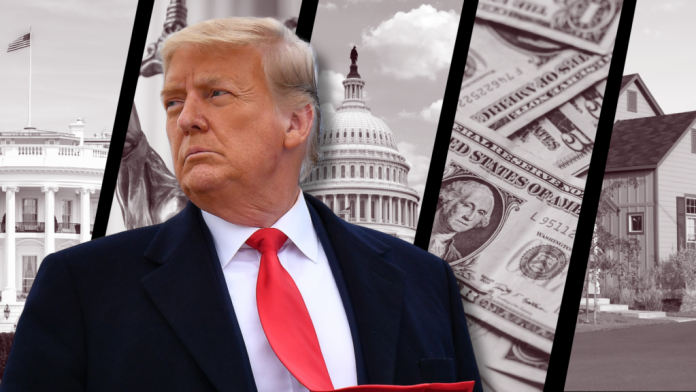Turn up the volume on your real estate success at Inman On Tour: Nashville! Connect with industry trailblazers and top-tier speakers to gain powerful insights, cutting-edge strategies, and invaluable connections. Elevate your business and achieve your boldest goals — all with Music City magic. Register now.
After spiking last week following the release of hot inflation data, mortgage rates are on the retreat again as bond market investors reassess the Trump administration’s approach to the economy, inflation and the Federal Reserve.
Applications for purchase mortgages were down by a seasonally adjusted 6 percent last week compared to the week before, but up 7 percent from a year ago, the Mortgage Bankers Association reported Wednesday.
Requests to refinance dropped 7 percent week over week, but were up 39 percent from a year ago, the MBA’s weekly survey of lenders found.
Joel Kan
“Mortgage rates decreased on average over the week, as markets brushed off unexpectedly strong inflation data,” MBA Deputy Chief Economist Joel Kan said in a statement. “Despite mortgage rates declining, with the 30-year fixed mortgage rate dropping to 6.93 percent, mortgage applications decreased to their slowest pace since the beginning of the year.”
TAKE THE INMAN INTEL INDEX SURVEY FOR FEBRUARY
In an attempt to exert more control over independent federal agencies, President Trump issued an executive order Tuesday requiring them to submit all proposed regulatory actions to the White House for review.
If it withstands expected legal challenges, the order would tighten the administration’s control over regulations and enforcement actions imposed on the financial sector by agencies like the Fed, the Securities and Exchange Commission (SEC) and the Federal Deposit Insurance Corporation (FDIC).
Fannie Mae and Freddie Mac’s federal regulator, the Federal Housing Finance Agency — an independent agency established by the Housing and Economic Recovery Act of 2008 — would also be subject to the order.
But the Trump administration specified that Tuesday’s order exerting control over independent agencies will not apply to the Fed’s interest rate decisions, which are made by the 12 policymakers who serve on the Federal Open Market Committee.
“This order shall apply to the Board of Governors of the Federal Reserve System only in connection with its conduct and authorities directly related to its supervision and regulation of financial institutions,” the executive order said.
While Trump has called for lower interest rates, Treasury Secretary Scott Bessent has signaled that the Trump administration doesn’t want a showdown with Federal Reserve Chairman Jerome Powell — a Trump appointee. Rather than ordering the central bank to lower short-term rates, the Trump administration plans to bring inflation down by boosting U.S. oil production, Bessent has said.
That stance acknowledges the reality that while the Fed has control over short-term rates, it’s bond market investors who fund most U.S. mortgages and government debt that have the ultimate say on long-term rates.
The Fed cut, and mortgage rates went up
As the Fed cut short-term interest rates in the final four months of 2024, mortgage rates climbed from a 2024 low of 6.03 percent on Sept. 17 to a 2025 high of 7.05 percent on Jan. 14, according to rate lock data tracked by Optimal Blue.
Bond market investors have speculated that Trump’s plans to impose tariffs, cut taxes and deport millions of immigrants could stoke inflation — a concern that’s increasingly shared by consumers, surveys show.
Tariffs on goods from Canada and Mexico that homebuilders warn could add to affordability woes are on hold, for now. But the Trump administration has upped duties on goods from China by 10 percent, and expanded tariffs on steel and aluminum imports are set to take effect next month.
After surging above 7 percent in January, mortgage rates were trending down again before the Feb. 12 release of the latest Consumer Price Index (CPI) data. The CPI report showed prices rose at an annual rate of 3 percent in January — the fourth consecutive move away from the Fed’s 2 percent inflation target.
The CPI report sent rates on 30-year fixed-rate mortgages surging back to 6.9 percent last week, but another more encouraging report on Feb. 13 — the Producer Price Index for January — helped bring rates back down.
“January’s PPI data were just the tonic after the bitter taste left by the CPI,” economists at Pantheon Macroeconomics said in their Feb. 14 U.S. Economic Monitor.
“With energy prices flat, productivity rising steadily and wage growth still cooling, it’s unsurprising that most business surveys point to modest price rises ahead,” Pantheon economists noted.
PPI and CPI data are components of the Fed’s preferred inflation gauge, the Personal Consumption Expenditures (PCE) price index, which will be updated on Feb. 28.
The additional 10 percent tariff on Chinese imports imposed by the Trump administration this month is likely to have only a small impact on core PCE inflation, which excludes food and energy prices, Pantheon forecasters predicted.
“We think core PCE inflation will be within touching distance of the 2 percent target by the end of this year if President Trump holds off imposing further tariffs,” Pantheon forecasters Samuel Tombs and Oliver Allen said.
If the 25 percent tariffs that Trump has threatened to place on all imports from Canada and Mexico are implemented, core PCE inflation “likely will hover at about 2.5 percent, this year, rather than rise, and [Fed policymakers] would have good reason to expect it to fall further in 2026,” Pantheon forecasters said. “Accordingly, we still think the chances of 2025 concluding without the [Fed] easing policy at all are remote.”
The CME FedWatch tool, which tracks futures markets to predict future Fed moves, showed that as of Feb. 19, investors see only a 17 percent chance that the Fed won’t cut rates this year, down from 30 percent on Feb. 12.
Fannie and Freddie privatization
Another factor that could put upward pressure on mortgage rates is the Trump administration’s plan to free the mortgage giants Fannie Mae and Freddie Mac from government conservatorship.
Investors who fund most home loans through purchases of mortgage-backed securities (MBS) that are backed by Fannie and Freddie might demand higher yields if the companies are privatized. But Trump’s Treasury Secretary, Scott Bessent, has said the administration has other priorities right now, such as extending 2017 tax cuts set to expire this year.

Scott Bessent
Before releasing Fannie and Freddie from conservatorship, the Trump administration would be attuned to “any study or hint that mortgage rates would go up,” Bessent told Bloomberg TV on Feb. 6. “Anything that is done around a safe and sound release is going to hinge on the effect on long-term mortgage rates.”
If the federal government continues to provide some kind of backstop to protect MBS investors, that could limit the impact privatization of Fannie and Freddie has on mortgage rates, proponents say.
During the first Trump administration, the National Association of Realtors proposed that Fannie and Freddie could be replaced by a new private entity that’s regulated like a public utility.
In endorsing the Trump administration’s nominee to head Fannie and Freddie’s federal regulator, homebuilder scion Bill Pulte, NAR renewed its call for the government to continue to play a role in housing finance.
The Federal Housing Finance Agency (FHFA), “will play a critical role in reshaping a housing market that faces record affordability challenges and a massive housing shortage,” NAR President Kevin Sears wrote to lawmakers on Feb. 6.

Kevin Sears
“A liquid financing market for mortgages, in particular the 30-year fixed-rate mortgage, must remain to build upon the foundations laid by previous FHFA Directors,” Sears said. “If now is indeed the time for reform of the GSEs, maintaining a federal backstop for mortgage-backed securities is vital. And while the conservatorships have dragged [on] past 16 years, there is great risk in rushing into any immediate solutions.”
Get Inman’s Mortgage Brief Newsletter delivered right to your inbox. A weekly roundup of all the biggest news in the world of mortgages and closings delivered every Wednesday. Click here to subscribe.
Email Matt Carter




